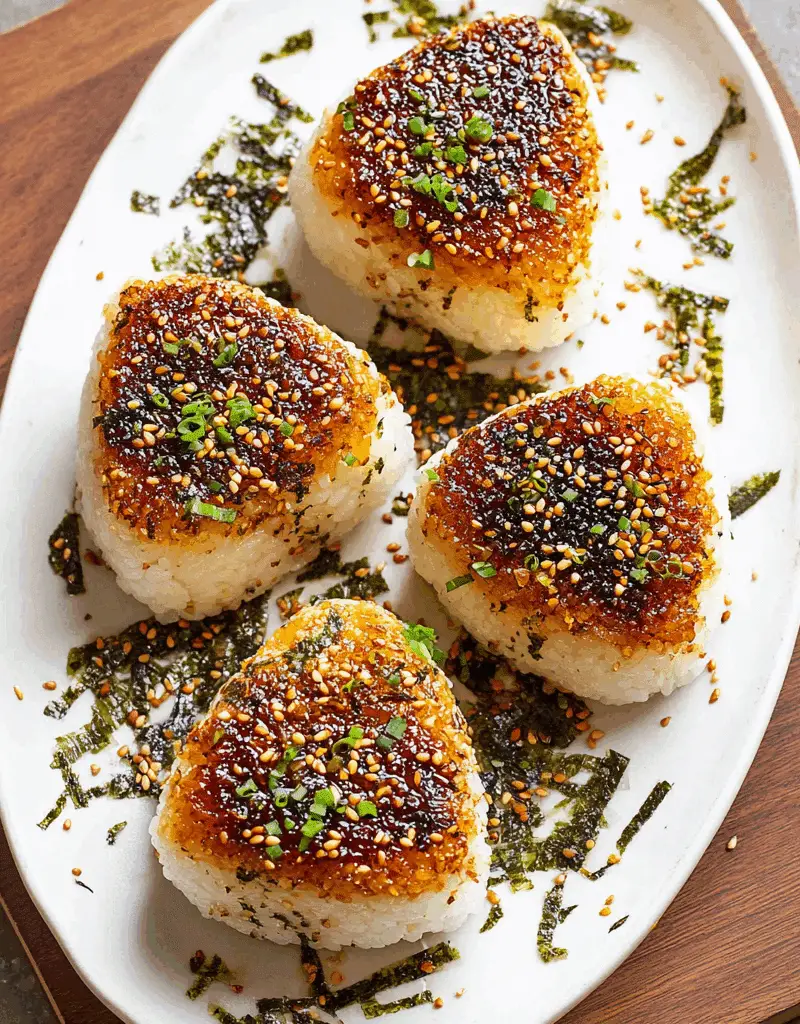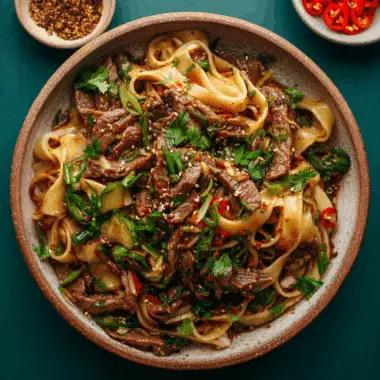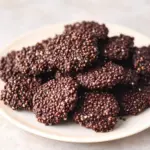The smoky aroma of Yaki Onigiri sizzling on a hot grill is enough to transport you to a bustling street corner in Tokyo. With a caramelized soy glaze and a satisfyingly crispy crust, these grilled rice balls are a beloved Japanese snack that’s both nostalgic and incredibly easy to make at home.
Perfect for bento boxes, casual snacking, or a cozy appetizer, these little triangles of joy offer deep umami flavor and crispy-chewy texture in every bite. You can customize them with fillings like miso paste, pickled plum, or grilled salmon, or keep it simple with a soy glaze and optional nori wrapping.
Full Recipe
Ingredients:
-
2 cups cooked Japanese short-grain rice (warm)
-
2 teaspoons soy sauce
-
1 teaspoon mirin (optional)
-
1 tablespoon neutral oil (vegetable or canola)
-
Toasted sesame seeds (optional)
-
Finely chopped green onions (optional)
-
Nori (seaweed), cut into strips (optional, for wrapping)
Directions:
-
Wet your hands with water and sprinkle with a pinch of salt to prevent sticking. Scoop about ½ cup of warm rice and shape into a triangle, pressing gently but firmly.
-
Heat a non-stick pan or grill pan over medium heat and lightly oil the surface.
-
Place the rice balls onto the pan and grill each side for 2–3 minutes, or until a crispy golden crust forms.
-
Mix soy sauce and mirin in a small bowl. Brush one side of the rice balls with the mixture and flip. Repeat for the other side.
-
Grill again for 1–2 minutes on each side after glazing to caramelize the sauce slightly.
-
Optional: Sprinkle with sesame seeds and green onions. Serve as is, or wrap with a strip of nori for easier handling.
Prep Time: 10 minutes | Cooking Time: 10 minutes | Total Time: 20 minutes
Kcal: 170 kcal | Servings: 4 rice balls
What is Yaki Onigiri?
Yaki Onigiri, or grilled rice balls, is a traditional Japanese dish made from plain or lightly seasoned rice shaped into compact triangles or rounds, then grilled to develop a golden, crispy crust. It’s a comforting, savory snack often brushed with soy sauce or miso paste and sometimes wrapped in nori (seaweed) for easier handling. The simplicity of the dish is what makes it so beloved across generations in Japan—it’s humble, satisfying, and packed with umami flavor. Unlike sushi, which often contains raw fish or seafood, Yaki Onigiri focuses on the integrity of the rice itself, showcasing how something so simple can be transformed with just a bit of heat and seasoning.
The Cultural Significance of Yaki Onigiri
In Japanese culture, Onigiri is more than just a meal—it’s a nostalgic symbol of home-cooked food, often associated with mothers preparing lunchboxes (bento) for their children or travelers carrying a simple meal on the go. Yaki Onigiri, specifically, adds a comforting warmth and aroma that comes from being cooked over an open flame or a hot pan. It’s a staple in izakayas (Japanese pubs), convenience stores, and home kitchens alike. While it remains a practical and easy snack, Yaki Onigiri is also seen as a symbol of Japanese culinary minimalism, where quality ingredients and care in preparation shine through without needing excessive flair.
Why You’ll Love Yaki Onigiri
Yaki Onigiri is everything you want in a quick snack or side dish: crunchy on the outside, tender on the inside, and full of deep, savory flavors. It’s naturally gluten-free (if you use tamari or gluten-free soy sauce), budget-friendly, and incredibly versatile. Whether served as an appetizer, alongside grilled meats, or as a lunchbox item, it hits that perfect balance between simplicity and indulgence. What’s more, it can be made with ingredients you probably already have—rice, soy sauce, and a bit of oil—and it requires no specialized equipment. This makes it an excellent choice for beginner cooks and seasoned chefs alike.
Origins and Evolution
While Onigiri itself has roots dating back to the Heian period (794–1185 AD), the grilled version became more popular as street food and comfort food in the 20th century. Traditionally, Onigiri was a way to preserve rice by compacting it into handheld portions, often with pickled or salted fillings that would keep for longer durations. Over time, as grilling became more accessible, cooks began toasting Onigiri over charcoal or flame, discovering that the texture and flavor elevated this humble rice ball into something more craveable. Today, many versions of Yaki Onigiri exist across Japan—from the soy-glazed variety to those filled with salmon, kombu (seaweed), or spicy cod roe (mentaiko).
Texture & Taste Profile
The key to Yaki Onigiri’s charm lies in its contrasting textures. The outer layer is grilled until crispy, developing a toasty, nutty flavor reminiscent of scorched rice at the bottom of a pot—something highly prized in many Asian cuisines. Meanwhile, the inside remains soft and steamy, offering a gentle contrast to the crunchy shell. When brushed with soy sauce or miso glaze, the rice absorbs the seasoning at the surface, becoming slightly caramelized and savory, while the inside maintains the neutral sweetness of the rice. Every bite is a delightful contrast of crispy and chewy, savory and mild.
Best Rice for Yaki Onigiri
To achieve the ideal texture, Japanese short-grain rice is essential. It’s sticky enough to hold its shape and compact well without falling apart. Medium-grain rice may work in a pinch, but long-grain varieties like basmati or jasmine lack the required stickiness and will likely crumble during grilling. Freshly cooked warm rice works best, as cold rice tends to be more difficult to mold and lacks the necessary moisture. It’s important not to over-season the rice before shaping since most of the flavor will come from the glaze and grilling process.
Ways to Customize Yaki Onigiri
Yaki Onigiri is incredibly customizable. While the classic version uses only soy sauce or miso for the glaze, you can experiment with other flavor enhancers like:
-
Miso paste mixed with a little mirin and sugar for a richer umami punch
-
Butter and soy sauce for a Western twist often found in Hokkaido-style Yaki Onigiri
-
Kimchi or chili paste for a spicy version
-
Inside fillings like grilled salmon, bonito flakes, pickled plum (umeboshi), or seasoned seaweed
You can also top them with toasted sesame seeds, green onions, or furikake (a Japanese rice seasoning mix) for extra flavor and texture. Wrapping them in a strip of nori not only adds a salty contrast but also makes them easier to handle when serving or packing for lunch.
Cooking Techniques and Equipment Tips
While traditional Yaki Onigiri is grilled over charcoal for that authentic smoky flavor, it’s absolutely possible to make them in a home kitchen. A non-stick skillet, cast iron pan, or even a stovetop grill pan will work well. If you’re using a broiler or oven, you can place them on a lined baking sheet and turn them periodically to ensure even browning. Brushing on the glaze near the end of cooking helps prevent burning and gives the rice that golden, lacquered finish. Don’t rush the grilling process—medium heat and patience will reward you with that perfect crunchy crust.
Serving Suggestions
Yaki Onigiri can be served hot off the pan or at room temperature. They make a satisfying accompaniment to miso soup, grilled vegetables, or skewers of yakitori chicken. For a fuller meal, consider pairing them with a side of Japanese pickles (tsukemono), a small salad with sesame dressing, or a chilled noodle dish like soba. They’re also an excellent addition to a bento lunchbox, providing substance and comfort between lighter components. Some like to serve Yaki Onigiri with a dipping sauce or a light dusting of shichimi togarashi (a Japanese chili spice blend) for added complexity.
Storing and Reheating Tips
If you have leftovers, wrap them tightly in plastic wrap or store in an airtight container and refrigerate for up to 2 days. While they’re best enjoyed fresh, you can reheat them in a skillet over medium heat to crisp them up again. A toaster oven or air fryer also works great to revive that crispy texture. Avoid using a microwave unless absolutely necessary, as it tends to make the rice chewy rather than crispy.
Dietary Information and Allergen Notes
Yaki Onigiri is naturally gluten-free when made with tamari or certified gluten-free soy sauce. It’s also dairy-free and vegan-friendly, depending on your glaze ingredients. Because the recipe is so simple, it’s easy to adapt for most dietary needs. Just be sure to double-check your condiments and any optional fillings you choose to ensure they meet your dietary preferences.
Why This Dish Resonates Globally
The appeal of Yaki Onigiri extends beyond Japan, thanks to its universal ingredients and the growing popularity of Japanese cuisine. As people become more interested in authentic, home-style meals from around the world, Yaki Onigiri offers a perfect introduction to the art of Japanese comfort food. It’s straightforward to prepare, visually charming, and incredibly satisfying. It taps into that universally comforting quality of crispy rice, much like socarrat in Spanish paella or tahdig in Persian cuisine.
Conclusion
Yaki Onigiri is a celebration of simplicity, transforming just a few pantry staples into a dish that’s rich in flavor, texture, and tradition. Whether you’re looking for a quick snack, an addition to your Japanese dinner spread, or a fun way to use leftover rice, these grilled rice balls deliver on all fronts. They require minimal ingredients, can be adapted to your taste, and hold up well for meals on the go. Once you taste that perfect balance of crispy outside and tender inside with the savory glaze seeping through, you’ll understand why Yaki Onigiri has stood the test of time in Japanese culinary history—and why it deserves a place in your home kitchen too.








